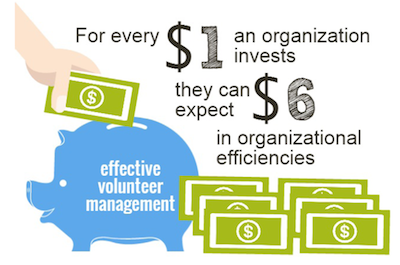What a Change in Perspective Can Mean for Your Volunteers
This post is by Tricia Thompson, vice president of training and consulting at Points of Light.
 Tricia Thompson
Tricia ThompsonIt’s time to get rid of our volunteer programs.
It seems harmless enough, but calling our volunteer activities “programs” often sets them up to compete with our direct service programs. At budget time, it can be hard to allocate scarce dollars to volunteer support because it seems like we are taking them from client support.
As an alternative, I propose reframing volunteer programs as volunteer strategies. This shifts their position from one that competes with clients to one that supports clients. From this new perspective, volunteer time becomes an asset to leverage on behalf of clients and the community, not a drain on resources.
Making the most of our assets requires an investment. Research from the Urban Institute tells us that the more we invest in volunteer engagement, the more our organizations will benefit from volunteer contributions.
It’s an intuitive finding that Service Enterprises – organizations that engage volunteers strategically to help meet their missions – have taken to heart, but one that many organizations still struggle with.

When we bring volunteers onboard without a plan, without time for clarifying expectations, without training the people who supervise them or without a clear sense of what they are best suited to offer, we often find that they don’t come back.
Without the investment of time that these tasks take, we end up with poor volunteer retention and staff who lament that they haven’t had a good experience with volunteers.
A volunteer strategy, like any effective operational strategy, addresses these issues with planning and an investment of time, energy and money. This planning and investment are hallmarks of Service Enterprises and any organization engaging volunteers strategically and well.
These organizations thoughtfully consider where volunteers are needed and in what ways they can best help the organization meet its mission. In return, operational volunteer strategies power their programs and help make them successful. In fact, Service Enterprises see up to a six-fold return on their volunteer investments.
The move toward volunteer strategies instead of programs also helps us think about ways that we can weave volunteers throughout our organizations – another characteristic of Service Enterprises.
Most of us engage direct service and board volunteers, but where else could volunteers support our work? An advocacy volunteer could promote our messages with key stakeholders and policy makers. A human resources volunteer could update the employee handbook so it meets current standards. An information technology volunteer could advise on the benefits and drawbacks of a new CRM (constituent relationship management) system.
The way we talk about volunteers influences the way we think about how we can partner with them.
Moving from a volunteer program to a volunteer strategy represents a subtle shift. But, it’s one that can have powerful and positive implications on how we practice volunteerism in our organizations.
What would that shift mean for your organization?
To learn more about Service Enterprises, and how your organization can become one, visit the Service Enterprise Intitiative website.
